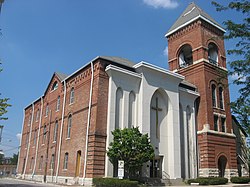Bethel A. M. E. Church | |
 The church building's exterior, 2011 | |
| Location | 414 W. Vermont St., Indianapolis, Indiana |
|---|---|
| Coordinates | 39°46′23″N 86°9′56″W / 39.77306°N 86.16556°W |
| Area | less than one acre |
| Built | 1869 |
| Architect | Adam Busch |
| Architectural style | Modern Movement, Romanesque, Post Modern |
| NRHP reference No. | 91000269[1] |
| Added to NRHP | March 21, 1991 |
The Bethel A.M.E. Church, known in its early years as Indianapolis Station or the Vermont Street Church, is a historic African Methodist Episcopal Church in Indianapolis, Indiana. Organized in 1836, it is the city's oldest African-American congregation. The three-story church on West Vermont Street dates to 1869 and was added to the National Register in 1991. The surrounding neighborhood, once the heart of downtown Indianapolis's African American community, significantly changed with post-World War II urban development that included new hotels, apartments, office space, museums, and the Indiana University–Purdue University at Indianapolis campus. In 2016 the congregation sold their deteriorating church, which was repurposed into part of a new hotel. The congregation built a new worship center at 6417 Zionsville Road in Pike Township in northwest Indianapolis.
The Bethel AME congregation has a long history of supporting the city's African American community. It is especially noted for its activities on behalf of the antislavery movement in the years before the American Civil War; its support of the Underground Railroad, which provided protection to slaves en route to Canada; and its commitment to education and community outreach. Bethel also served as the mother church to several AME congregations in Indiana and as a public meeting place in Indianapolis for social activists. Local chapters of the National Association for the Advancement of Colored People and the Indiana State Federation of Colored Women's Clubs were organized at the Vermont Street church in the early 1900s.


